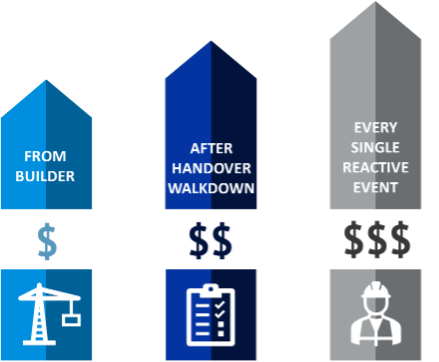
BLOG
—
Why Asset Data is Cheapest During Construction
With Real-Life Examples to Prove It
As I evangelize the value of improving digital asset data delivery during capital projects, there is one common and immediate response I often receive: it’s never funded because it’s an additional project cost that’s easy to cut. Unfortunately, this perception is both widespread and shortsighted. It is true that looking at just the costs associated with designing and constructing the project, any additional effort put into capturing better digital asset data will appear extraneous and unnecessary. However, you must expand your horizons to view the entire asset life cycle, which includes those pesky 10, 20 and sometimes more than 50 years of asset operation and maintenance. That mental shift enables you to see that the upfront cost of collecting good asset data is actually minuscule, and an incredibly wise investment to boot.
The truth of the matter is that capturing asset data will happen at some point in the asset’s life cycle, no matter what. The reason? Data collection plays a role in both the proper and improper operation and maintenance of the asset. In other words, if you have good asset data up front, you can optimize the operations and maintenance strategy related to that asset, driving down the total cost of ownership (TCO). If you don’t have this data upfront, you will certainly be scrambling for it when the asset fails. Don’t believe me? Let’s look at three likely scenarios for asset data capture and demonstrate why getting it at the beginning is the most cost-effective.
Up Front as Part of Project Handover
When digital asset data is a project deliverable, the data is captured as efficiently as possible while it is being created. Contractors are most likely compiling this information in the form of BIM design models, shop drawings, piping and instrumentation diagrams or product data submittals and then taking one more step to format the data to client specifications. Additionally, field installation verifications and asset labeling can happen as the asset goes in before it is hidden under floors, behind walls, above ceilings and by other assets. This method has the added benefit of being available during the critical initial period of the “bathtub curve” during which asset failures occur at higher rates. In my experience, asset data collection during this phase typically costs less than half a percent of the total project cost on large projects. That’s no more than a rounding error on the bottom line.
Post-Project Completion Walkdown
Now, I’m very familiar with this method because I ran a company with a service line dedicated to this activity. This process is both messy and relatively expensive. Whether you are using outside contractors or internal resources, you are asking those individuals—typically with limited expertise in the asset types and minimal information about the as-built context—to go on a treasure hunt for asset data. This process involves significant preparation and research to evaluate the multiple design plans/drawings needed to determine collection activities as well as coordination with operations to shut down specific areas or access restricted/concealed ones. It also takes countless hours of searching to locate or relocate product data. In my experience, the cost of these efforts (at scale) can approach that of a minor capital project or IT system implementation.

Never
The third available option, which is unfortunately used quite often, is to never formally collect asset data. While this may seem to have the lowest associated cost, I would argue that it is the most expensive option. The fact of the matter is that when failures occur with your assets and systems (and they will), maintenance planners and technicians require accurate data to remedy the issues. That data could include accurate physical locations, as-installed configurations, appropriate and safe shutdown and maintenance procedures and applicable spare parts. Make no mistake: if this data is not readily available for planners or technicians, they will need to find it when addressing the maintenance of that asset. As such, instead of paying for the data once, you must pay for it literally every time a work order is executed during the asset’s life cycle. That’s not to mention the hidden opportunity cost of lacking the data to optimize operations and maintenance to avoid the failure and decrease TCO. The bottom-line cost of this option can be incalculable.
You must push your organization to create digital asset data deliverable standards for capital projects. If you hear the common argument that it adds too much cost to the overall project, remind the naysayers that they will end up paying for the data one way or another. Being proactive ensures that you get that data at the lowest possible cost with the greatest possible value!
Share this Post
